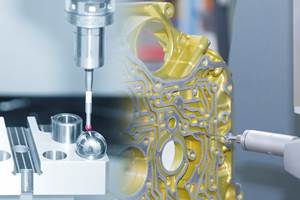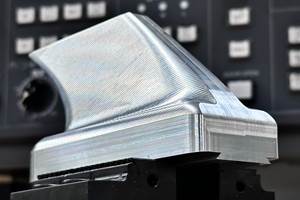Making CNC-Related Decisions
The diversity and similarity of components, manufacturing processes and machine tools must be considered to optimize your production process.
Share





The number of different component workpieces your company produces on its CNC machines is probably sizable. In companies that produce products, this may be a finite and relatively stable number—the total of machined components comprising the company’s products. This number only changes when new products are added or old ones become obsolete. On the other hand, most companies that produce workpieces or tooling must regularly produce new and different components as new orders come in. In this case, the number of components being produced increases daily.
What variations complicate a CNC environment?
There are three closely related diversities that complicate your company’s CNC environment:
- Component/workpiece diversity, which is determined by the number and complexity of products/services your company provides.
- Manufacturing process diversity, which is determined by diversity among components.
- Machine tool diversity, which is determined by diversity of manufacturing processes.
Companies that produce products must be able produce or procure all components comprising their products. The greater the component diversity, the greater the number of required manufacturing processes. Processes may require many kinds of CNC machines, including metalcutting machines, sheet-metal-fabrication machines, electrical discharge machines, grinding machines and additive manufacturing machines.
To complicate matters further, many companies that produce products have support departments that use CNC machine tools, like tool rooms to provide production tooling and/or R&D to create prototypes.
Although these companies tend to have the most diverse manufacturing and CNC environments, many produce similar products in different sizes or degrees of functionality. Consider a company that produces pneumatic or hydraulic cylinders: All components of the same kind (like cylinders, sleeves, pistons or end caps) have the same basic function. What changes most among them is their size. For this reason, most companies that produce products have at least some components that fall into part families.
Companies that produce workpieces usually have great diversity in the range of components being produced because they provide workpieces for a variety of product-producing customers. While this complicates the CNC environment, many job shops focus on just a limited number of different manufacturing processes. They may, for example, specialize in metalcutting processes and would not perform sheet-metal fabrication or EDM processes.
Companies that produce tooling tend to specialize in a limited number of tooling types. A mold shop, for instance, produces molds—and only molds of the same type (injection, vacuum, etc.). A typical mold shop would not produce other types of tooling, like dies, fixtures or gages. Also, many of the company’s individual components will fall into part families.
Component diversity and, in turn, process diversity, is directly related to the kind of tooling being produced. A die shop, for instance, will need to produce or procure the components comprising a die set. CNC-related processes will likely include metalcutting processes, wire EDM processes and grinding processes.
Though you should strive for consistency, the more diverse your CNC environment, the more difficult it is to make decisions that are universally appropriate. Consider these examples:
- Programming methods. Parametric programming (with custom macro or with CAM systems) is great for part families but is not feasible when there is a high degree of component diversity. Most CAM systems excel with some manufacturing processes but not with others. A CAM system that nicely handles sliding-headstock-lathe applications, for instance, will probably not do as well for a five-axis machining center.
- Department layout. Manufacturing cells are great for part families. All equipment required to completely produce closely related components is placed together, regardless process or machine tool type. To produce higher-complexity components, however, it makes more sense to group departments by manufacturing process—mill department, lathe department and so on. Components are routed to each department for a required manufacturing processes.
- Workholding setup methods. It is easier to justify what it takes to qualify workholding setups when there is little diversity among components. This, in turn, makes it possible to eliminate the task of program-zero assignment. Qualifying workholding setups when components vary is more difficult to justify since each component must be considered separately. You can often utilize one fixture to secure multiple similar components. Dissimilar components will each require their own fixturing.
- Cutting tool considerations. Similar components often require similar cutting tools, meaning you can probably come up with a set number of “standard” cutting tools that will be used for all components. Keep them assembled and track offset information to minimize setup time. You may even be able to store them in the machine if it has enough tool stations. With dissimilar components, you may still be able to come up with some common cutting tools, but you will not be able to keep all cutting tools assembled nor store them all in the machine.
Admittedly, these are but a few examples of the countless diversity-related considerations that affect your company’s productivity. You must ensure that decisions are appropriate to your company’s needs.
Related Content
6 Variations That Kill Productivity
The act of qualifying CNC programs is largely related to eliminating variations, which can be a daunting task when you consider how many things can change from one time a job is run to the next.
Read MoreRethink Quality Control to Increase Productivity, Decrease Scrap
Verifying parts is essential to documenting quality, and there are a few best practices that can make the quality control process more efficient.
Read MoreCustom Workholding Principles to Live By
Workholding solutions can take on infinite forms and all would be correct to some degree. Follow these tips to help optimize custom workholding solutions.
Read MoreHow to Meet Aerospace’s Material Challenges and More at IMTS
Succeeding in aerospace manufacturing requires high-performing processes paired with high-performance machine tools. IMTS can help you find both.
Read MoreRead Next
Machine Shop MBA
Making Chips and Modern Machine Shop are teaming up for a new podcast series called Machine Shop MBA—designed to help manufacturers measure their success against the industry’s best. Through the lens of the Top Shops benchmarking program, the series explores the KPIs that set high-performing shops apart, from machine utilization and first-pass yield to employee engagement and revenue per employee.
Read MoreAMRs Are Moving Into Manufacturing: 4 Considerations for Implementation
AMRs can provide a flexible, easy-to-use automation platform so long as manufacturers choose a suitable task and prepare their facilities.
Read More.jpg;width=70;height=70;mode=crop)






















